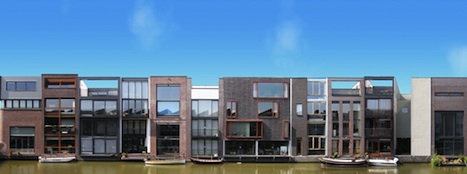The Eastern Docklands
Exploring the countless attractions in central Amsterdam generally couldn't be easier - in most cases you need only step out of your hotel and walk in virtually any direction until you run into a pretty canal, flower market, or museum. The Eastern Docklands, a relatively recent addition to the cityscape, is somewhat of an eccentric, distant cousin of the Amsterdam family. A mix of functional and funky, cultural and residential, the islands and peninsulas of the Docklands are the perfect place to see contemporary Dutch urban design in action.
The Eastern Docklands sprung up from swampland in the 19th century, when ports and warehouses needed to relocate for the construction of the Centraal railway station along the river IJ. After the war, most of the buildings fell into disuse and in the 1970s the city began demolishing the buildings in what had become a rather barren, derelict neighborhood. In the meantime, artists and squatters began to move in, keen to make the most of the abandoned warehouses, drawing attention to the historic importance and cultural possibilities of the Eastern Docklands. In the 1980s, reconstruction and reorganization was undertaken by the city of Amsterdam on a huge scale, transforming old buildings into modern homes, cafes, and museums, and planning new residential districts with functional, innovative designs.
The Eastern Docklands is a loose term which typically includes the districts, islands, and peninsulas of KNSM Island, Java Island, Oostelijke Handelskade, Rietlanden, and several Zeeburg peninsulas including Sporenburg, Borneo, and Cruqius. For our purposes, we'll also include Oostelijke Eilanden (Eastern Islands), an adjacent, older neighborhood which dates back to to the 17th century, but has also undergone redevelopment in recent years.
The best way to visit the Eastern Docklands is by hopping on a tram - number 10 goes along the Singelgracht (Singel canal) stopping at Leidseplein and Weesterplein before heading to the Docklands and ending on KNSM Island. Another option is to hop on the 26 tram from Centraal Station, which stops along the Oostelijke Handelskade and in Rietlanden before going into the Piet Heintunnel further east. But if you plan on exploring the Eastern Docklands in their entirety, the best choice is to rent a bicycle - not only do you get the chance to enjoy all of the unique paths and bike bridges of the Docklands, but the distances here can also be quite far for walking, in comparison to Amsterdam's city centre.

Starting from the western edge of Oostelijke Handelskade, the first building you'll see is the Muziekgebouw aan 't IJ and the partially integrated Bimhuis, two brand new, award-winning glass and concrete buildings jutting out into the river IJ. The latter specializes in jazz and improvised music, while the former typically hosts contemporary classical concerts.
Passing by the many hotels and office buildings of Piet Heinkade, you will eventually meet Oostelijke Handelskade street proper, which is home to several well-preserved brick warehouses from the 19th century. Many of these have been converted, with impressive panache, to restaurants, clubs, and cultural centres, such as KHL Restaurant, Panama club, and the Pakhuis de Zwijger cultural centre.
At this point you can head south for a little stroll in the older Oostelijke Eilanden peninsulas, which are home the recently renovated and much-lauded Maritime Museum (Het Scheepvaartmuseum). Because of its past as a hub for shipping activities, many historic buildings and warehouses once belonging to the Dutch East India Company are located here, particularly along Oostenburgergracht. An unmistakable recent addition to this district has been the aqua green NEMO science centre, which is particularly popular with children (signage inside is in both English and Dutch).
On the opposite side of the Eastern Docklands are three peninsulas belonging to the Zeeburg district: Sporenburg, Borneo, and Cruqius. While Cruquis has a few curious examples of 19th century warehouses-turned-residential blocks, these "islands" are largely residential, family-friendly, and mostly built in the 1990s. On your way north, to Java and KNSM, make sure to take note of the Lloyd Hotel. One of the city's most unusual hotels, a new energy was injected into this 1920's building when dozens of forward-thinking Dutch designers got involved. Luxurious, basic, design-conscious, and functional all apply to this bizarre, multi-faceted place.
The last island to explore is Java and KNSM, the latter named after the Koninklijke Nederlandse Stoomboot-Maatschappij - the Royal Dutch Steamboat Company, which was based on the island from the mid-19th to the mid-20th century. Today, KNSM is most visited for its quirky cafes and innovative design shops, which line its central KNSM-Laan road. On the western tip lies the Java peninsula, where you can see some of the most creative takes on contemporary residential architecture, inspired by the 17-th century canal houses of central Amsterdam. Each individual house along the four canals of Java leans forward at its own angle, and the mish-mash of materials and colours show a sense of playfulness - without sacrificing any much-needed functionality.
Now that you've explored one of Amsterdam's most eccentric neighborhoods, why stop here? The northern bank of the IJ with its NDSM shipyard, as well as the IJburg district even further east, are both whispered to be the next big thing...